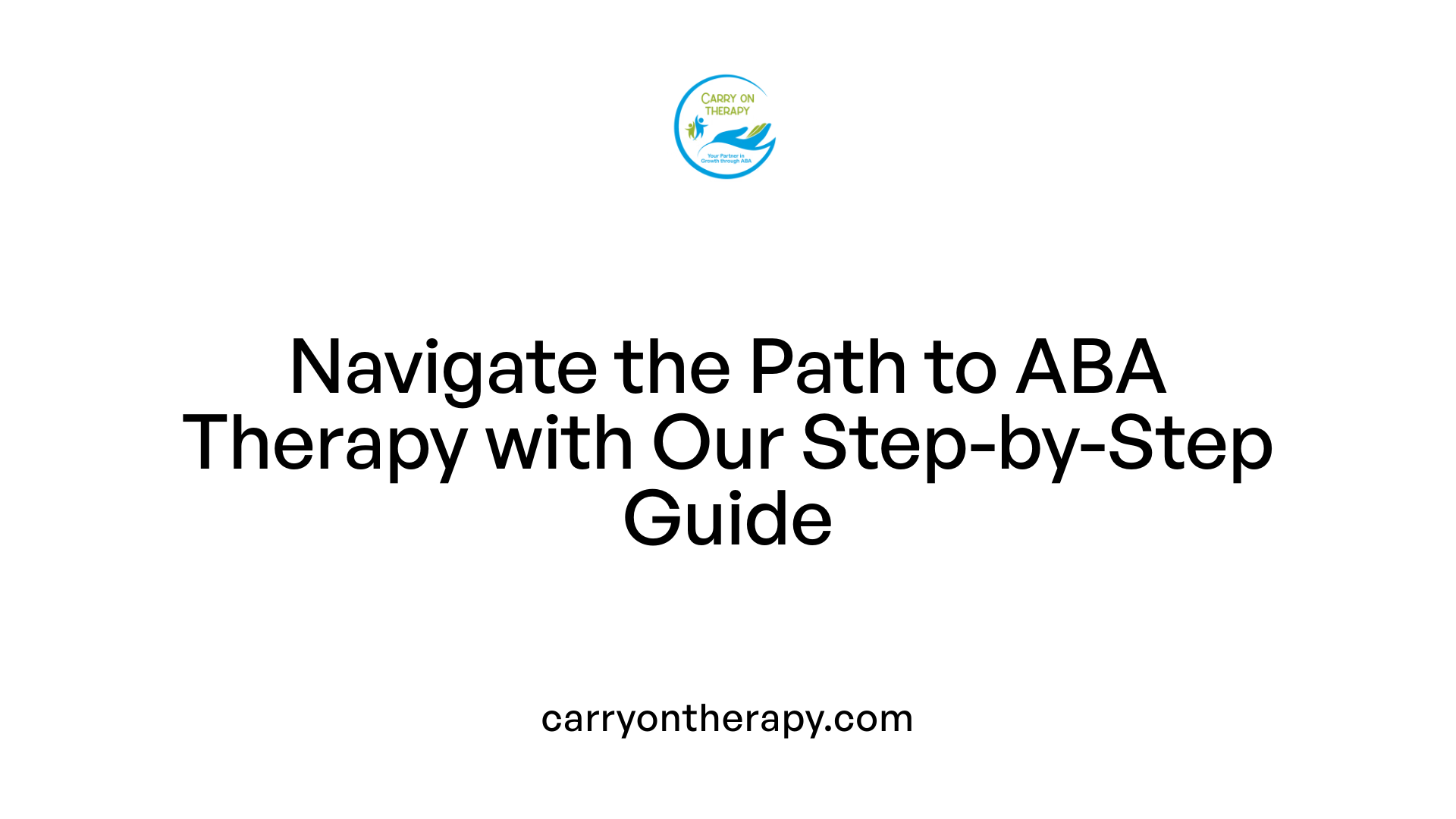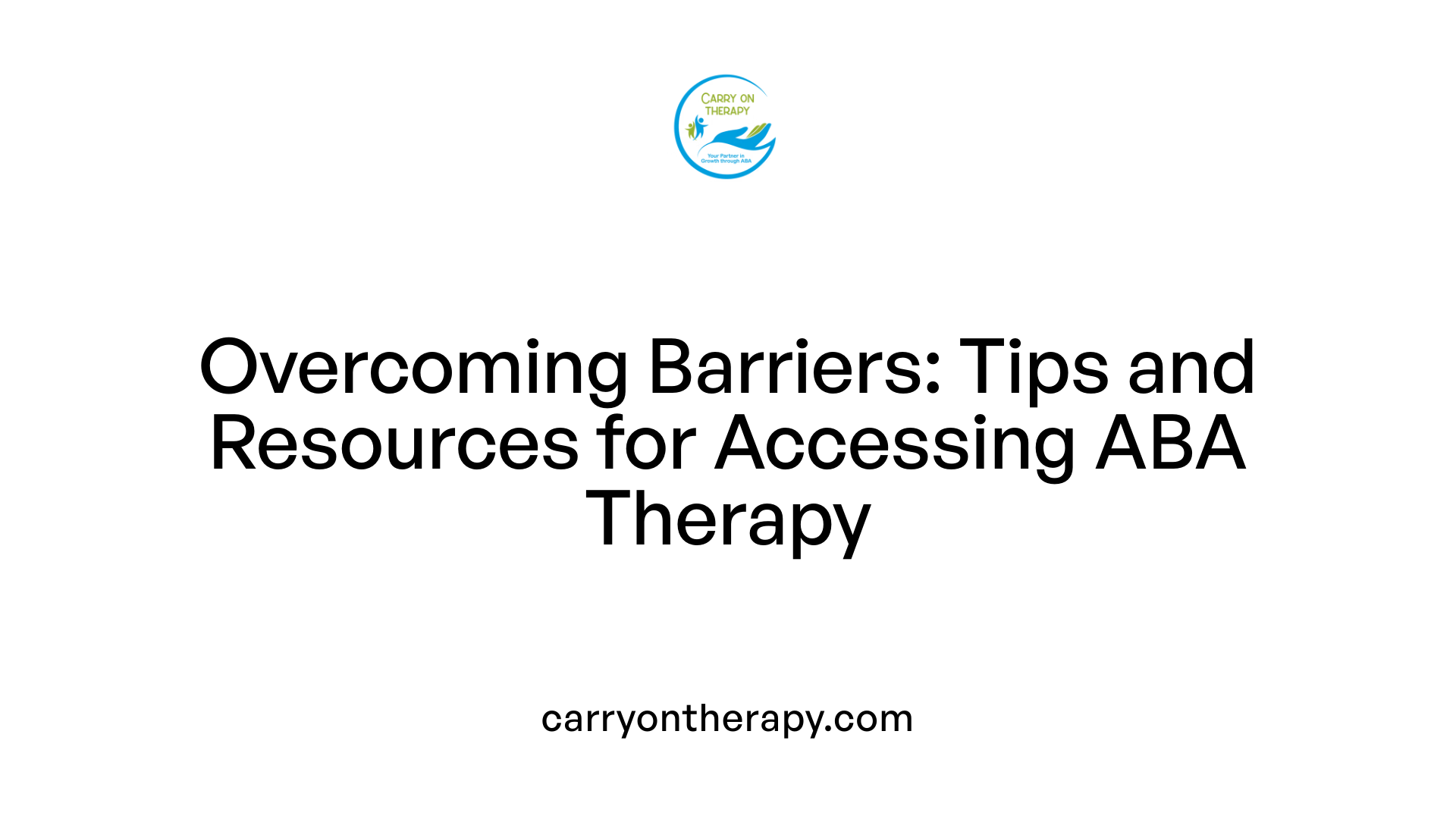Understanding Autism Treatment Options
Navigating the healthcare system to obtain effective autism treatment can feel daunting for families and caregivers. With various therapy approaches, insurance requirements, and provider qualifications, the process requires informed steps to ensure timely and tailored care. This article provides a clear roadmap to help families understand behavioral therapy for autism, especially Applied Behavior Analysis (ABA), the benefits it offers, how to secure therapy through Medicaid programs like Indiana's, and overcoming common challenges along the way.
What Is Behavioral Therapy for Autism and How Does It Work?
Definition and Principles of Applied Behavior Analysis (ABA)
Applied Behavior Analysis (ABA) is a science-based method designed to improve behaviors by understanding and influencing the relationship between a person's actions and the environment. It focuses on increasing useful skills like communication and social interaction while decreasing behaviors that may interfere with learning or daily life.
How ABA Targets Communication, Social Skills, and Adaptive Behaviors
ABA programs work by breaking down complex skills into smaller, manageable tasks. For children with autism, ABA helps develop critical abilities such as preparing for school, improving behavior, socializing with others, and self-care. It achieves this by using techniques such as prompts, reinforcement, and repetition until the child masters the skills.
Structure of ABA Programs Including Prompts, Reinforcement, and Skill Generalization
A typical ABA program includes structured work times, play, and group activities. It begins with goal setting and uses prompts—like modeling or verbal cues—to guide the child. Positive reinforcement is provided when the child performs a desired behavior, encouraging them to repeat it. Skills are practiced until mastery and then generalized, meaning the child can apply them in various settings and situations beyond the therapy sessions.
Role of Qualified Professionals Like Board Certified Behavior Analysts (BCBAs) in Designing Personalized Plans
Behavioral therapy through ABA is designed and supervised by trained professionals, specifically Board Certified Behavior Analysts (BCBAs). They assess each child’s unique needs, create tailored treatment plans, monitor progress through regular skill measurements, and adjust approaches accordingly. Qualified therapists such as Registered Behavior Technicians (RBTs) often deliver the therapy under BCBA supervision.
Different ABA Approaches Such as Discrete Trial Training and Pivotal Response Training
ABA offers several specialized methods to suit individual learning preferences. These include Discrete Trial Training (DTT) which involves clear, structured teaching trials; Pivotal Response Training (PRT) which targets motivation and responses to multiple cues; and Verbal Behavior Approach focusing on communication skills. Therapies blend these methods to best support each child.
Environment Adaptability From Clinical Settings to the Home
ABA therapy is adaptable and can be delivered in various environments. While some sessions happen in clinical or school settings, many techniques translate into natural environments like the home. Simple directions, reinforcement strategies, and gradual progression of skills help children practice and strengthen behaviors in daily life, with family members playing a crucial role in supporting this learning outside of formal sessions.
Benefits of Behavioral Therapy for Individuals with Autism

What Are the Benefits of Behavioral Therapy for People with Autism?
Behavioral therapy, especially Applied Behavior Analysis (ABA), brings remarkable benefits to individuals with autism. It improves communication skills and encourages social interaction, making daily socializing easier and more natural. By reducing problematic behaviors and reinforcing positive ones, ABA helps create a supportive learning environment.
How Does ABA Enhance Daily Living and Self-Care Abilities?
ABA fosters essential skills such as self-care and preparing for school, which boost independence in everyday activities. This therapy uses structured teaching, prompts, and positive reinforcement to aid children in mastering tasks and generalizing skills across settings—from home to school.
Why Is Early Intervention Important?
Starting ABA early, ideally between ages 2 and 6, provides greater chances for progress in communication, social skills, and behavior. Additionally, therapy delivered consistently for 10 to 40 hours weekly, tailored through regular assessments, optimizes benefits and supports long-term independence.
What Are the Long-Term Benefits?
Over time, individuals receiving ABA therapy often show improved independence and better integration into their communities. Enhancing foundational abilities early enables stronger functioning in social, academic, and daily environments.
What Does Scientific Evidence Say About ABA?
Decades of research support ABA as an effective, evidence-based approach for autism. Personalization by qualified professionals ensures therapy addresses unique needs, making ABA a trusted technique to enhance quality of life and skill development for people with autism.
Who Provides Behavioral Therapy for Autism and Where?

Who typically provides behavioral therapy for individuals with autism?
Behavioral therapy for autism is mainly delivered by professionals trained in Applied Behavior Analysis (ABA). This includes Board Certified Behavior Analysts (BCBAs), licensed behavior therapists, and Registered Behavior Technicians (RBTs) who work under supervision. These specialists design and implement individualized plans to teach children vital skills, improve behavior, and promote independence.
Settings where behavioral therapy is delivered such as clinics, schools, and home
ABA therapy is flexible and delivered across multiple environments tailored to each child’s needs. Common settings include:
- Clinics or therapy centers equipped for structured learning
- School environments where therapy integrates with educational goals
- Home settings to generalize skills in natural contexts Including home sessions helps families reinforce lessons with simple directions and positive reinforcement.
Importance of family involvement and training
Family participation is essential in ABA therapy. Therapists often train parents and caregivers to apply strategies consistently at home, ensuring learning extends beyond sessions. This collaborative approach fosters better outcomes and empowers families.
Role of multidisciplinary teams including speech and occupational therapists
Behavioral therapy is frequently part of a multidisciplinary approach. Speech therapists and occupational therapists collaborate with BCBAs to address communication, sensory needs, and motor skills, offering holistic support.
Examples of specialized organizations providing ABA therapy
Providers like Patterson Behavior Services and Autism Care Partners offer comprehensive ABA programs. They employ specialized staff to deliver evidence-based interventions customized to individual goals.
Challenges in provider availability related to rural or underserved communities
Access to qualified providers can be limited in rural or underserved areas due to fewer trained professionals and lower reimbursement rates. These challenges affect therapy availability, underscoring the need for expanded resources and telehealth options.
Understanding Medicaid Coverage for ABA Therapy

Who Is Eligible for ABA Therapy Through Indiana Medicaid?
To qualify for Applied Behavior Analysis (ABA) therapy under Indiana Medicaid, a child or young adult must be enrolled in Medicaid or the Children's Health Insurance Program (CHIP). They must also have a formal diagnosis of autism spectrum disorder or a related condition from a licensed healthcare provider. Eligibility also requires a determination of medical necessity and completion of prior authorization steps.
What Is the Authorization Process?
Obtaining Medicaid coverage for ABA involves several key steps. Families need a formal diagnosis and a referral from their healthcare provider. Then they must submit a prior authorization request to Medicaid, including the diagnosis details, a treatment plan outlining goals and expected hours of therapy, and relevant documentation. This process ensures that the therapy plan meets medical standards and the individual's needs.
What Services Does Medicaid Cover?
Indiana Medicaid includes various ABA services such as comprehensive therapy focusing on a broad range of skills, focused interventions targeting specific behaviors, and social skills training. These programs aim to support children's development in areas like school preparation, socializing, and self-care.
How Many Hours of Therapy Are Typically Covered?
Children receiving ABA therapy often get between 10 to 40 hours of weekly treatment, depending on their individual requirements. The therapy is adjusted regularly based on assessments that usually occur every 6 to 12 months to ensure ongoing effectiveness and necessity.
What Are the Out-of-Pocket Costs?
Most families experience little to no out-of-pocket expenses when accessing ABA therapy through Medicaid. However, for those covered under CHIP, there may be minimal co-pays associated with the services.
Who Can Provide ABA Therapy Under Medicaid?
Qualified providers include licensed professionals such as Board Certified Behavior Analysts (BCBAs) or Registered Behavior Technicians (RBTs) working under BCBA supervision. These credentials ensure that therapy is delivered by trained and competent individuals who can tailor and monitor the treatment effectively.
Step-by-Step Guide to Securing ABA Therapy Through Medicaid

Obtaining a Formal Autism Diagnosis from Licensed Providers
The first essential step in accessing ABA therapy through Indiana Medicaid is securing a formal diagnosis of autism or a related disorder. This diagnosis must come from a licensed healthcare provider, ensuring that the child is appropriately assessed and eligible for services.
Referral Process to Behavioral Therapy Providers
Once a diagnosis is confirmed, families need to get a referral from their healthcare provider to begin behavioral therapy. This referral acts as a professional recommendation and facilitates connection to qualified behavioral therapists.
Submitting Prior Authorization with Treatment Plans and Expected Therapy Hours
Before ABA therapy can officially start, Medicaid requires prior authorization. This involves submitting detailed documentation, including the child's diagnosis, a personalized treatment plan outlining therapy goals, and the estimated number of therapy hours per week. Most children receive 10 to 40 hours based on their individual needs.
Identifying Qualified Providers Under Medicaid Reimbursement Rules
Medicaid covers therapy provided by licensed professionals, such as Board Certified Behavior Analysts (BCBAs) or Registered Behavior Technicians (RBTs) under BCBA supervision. Families must ensure they select approved providers to guarantee coverage.
Monitoring and Renewal of Therapy Authorization Every 6 to 12 Months
ABA therapy authorization is not indefinite. Medicaid requires ongoing assessments of the child's progress every 6 to 12 months. These evaluations help determine medical necessity and support renewal of therapy services.
Navigating Paperwork and Understanding Medicaid’s Medical Necessity Criteria
Completing applications for ABA therapy involves careful attention to required documentation and understanding Medicaid's criteria for medical necessity. Assistance from support organizations can help families manage paperwork and advocate for appropriate coverage.
By following these steps, families can effectively navigate the Medicaid system to secure vital ABA therapy support for their children with autism.
Common Challenges Families Face and How to Overcome Them

Delays in Authorization Approvals and Paperwork Hurdles
One major challenge families encounter is the time-consuming process of obtaining prior authorization for ABA therapy under Medicaid. This process requires submitting detailed documentation such as formal diagnosis, treatment plans, and expected therapy hours. These paperwork requirements can delay the start of needed services.
Limited Provider Options Especially in Rural Areas
Access to qualified ABA providers, including Board Certified Behavior Analysts (BCBAs) and Registered Behavior Technicians (RBTs), is often limited in rural regions. This scarcity impacts timely access to therapy for many families, forcing longer wait times or travel to distant locations.
Insurance Reimbursement Rates Affecting Provider Availability
Medicaid reimbursement rates for ABA therapy sometimes result in fewer providers willing to accept patients due to lower compensation. This economic factor further restricts available therapist options and may increase service wait times.
Navigating Co-Pays, Especially Under CHIP Coverage
While Indiana Medicaid generally covers ABA therapy with minimal out-of-pocket costs, families enrolled in the Children’s Health Insurance Program (CHIP) may face small co-pays. Understanding these costs and budgeting accordingly is important for ongoing care continuity.
Importance of Advocacy and Parental Involvement
Proactive advocacy by parents and caregivers is essential. Staying engaged during the prior authorization process, documenting progress, and communicating with providers helps ensure appropriate care is received without unnecessary delays.
Resources Available From Support Organizations
Support groups like The Arc of Indiana, Autism Society of Indiana, and Indiana Resource Center for Autism offer invaluable guidance. They assist families in navigating the complex Medicaid system, provide legal support, help challenge denials, and connect parents with community resources.
Being aware of these challenges and actively using available supports can improve access and outcomes for children receiving ABA therapy through Medicaid.
Resources and Support for Navigating Autism Treatment
Role of Organizations Offering Guidance, Legal Support, and Advocacy
Families seeking ABA therapy and autism services in Indiana can turn to key organizations like The Arc of Indiana, Autism Society of Indiana, and Indiana Resource Center for Autism. These groups provide essential guidance on navigating insurance coverage and legal rights, as well as advocating for improved access to services.
How Families Can Get Assistance with Insurance and Healthcare Navigation
These organizations assist families in understanding Medicaid and CHIP eligibility criteria, completing prior authorization paperwork, and advocating for coverage of ABA therapy. They act as a bridge between families, providers, and healthcare systems to reduce barriers in accessing care.
Availability of Educational Materials About ABA Therapy and Autism Services
Families can access a wide range of educational resources through these organizations, including brochures, webinars, and online articles explaining ABA therapy processes, benefits, and how to implement skills at home.
Community-Based Support Networks and Informational Workshops
Local chapters and resource centers frequently host workshops, support groups, and events. These opportunities connect families with professionals and peers, fostering community support and information sharing.
Contact Information and Online Resources for Indiana-Specific Assistance
Families looking for Indiana-based help can visit:
- The Arc of Indiana: www.arcind.org
- Autism Society of Indiana: www.autismindiana.org
- Indiana Resource Center for Autism: www.iidc.indiana.edu/irca These websites offer contact details, event calendars, and online help portals to guide families through the ABA therapy journey.
Empowering Families through Knowledge and Resources
Successfully navigating the healthcare system for autism treatment hinges on understanding behavioral therapy options, particularly ABA, and how to access these services through Medicaid and qualified providers. Early intervention and professional guidance maximize the benefits for children and young adults with autism. Despite challenges such as authorization delays and limited provider availability, families can leverage support organizations and advocacy groups to ensure timely access to quality therapy. With informed steps and the right resources, families can secure personalized autism treatments that significantly enhance development, independence, and quality of life.
References
- Applied Behavior Analysis (ABA) for Children With Autism
- How to Get ABA Therapy Via Medicaid in Indiana [2025 ...
- Applied Behavior Analysis (ABA)
- 6 Benefits of ABA Therapy for Children with Autism
- Behavioral Therapy for Autism Spectrum Disorder in Children
- The Top 10 Reasons Children With Autism Deserve ABA
- Behavioral Management Therapy for Autism | NICHD
- Applied Behavior Analysis (ABA)
- Behavioral Management Therapy for Autism | NICHD
- Treatment and Intervention for Autism Spectrum Disorder
You have to Start to be Great!






